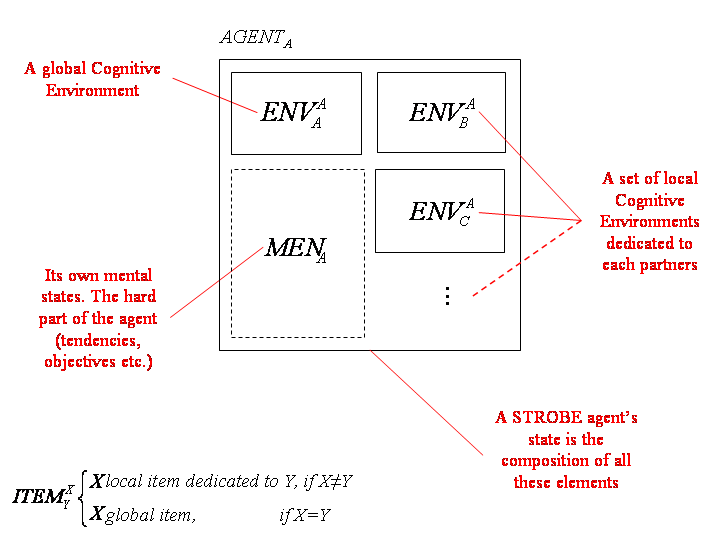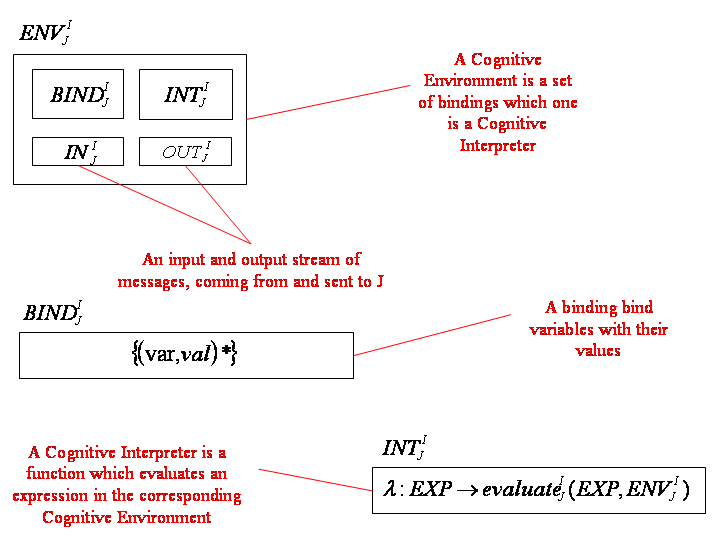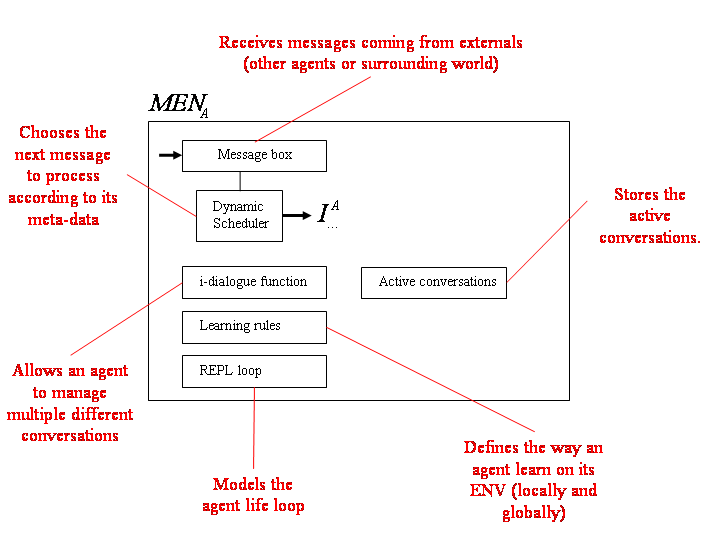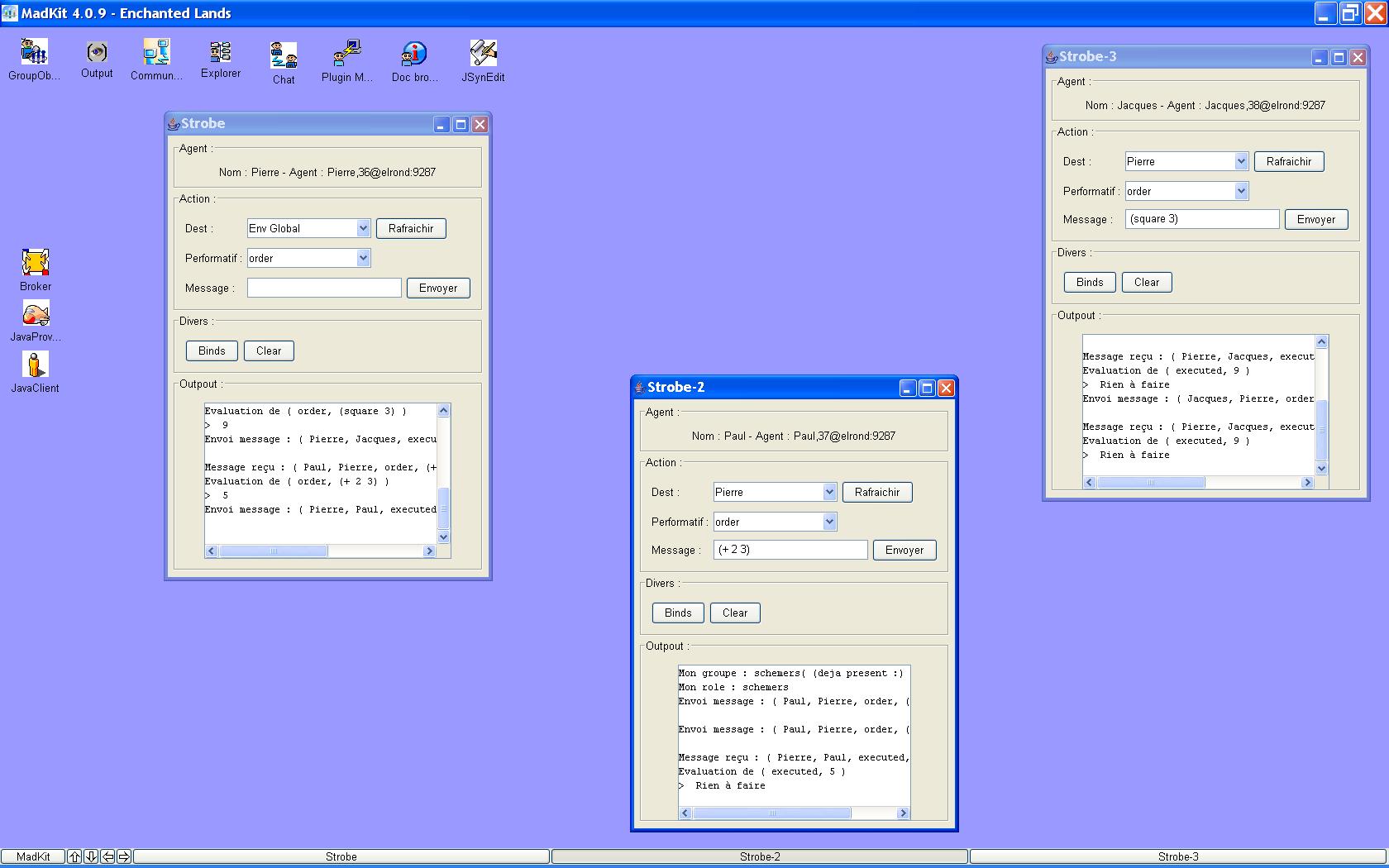Presentation
The STROBE (STReam, OBject, Environment) model is an agent
representation and communication model firstly proposed
in the 90's by Pr. Stefano A. Cerri. The STROBE model's evolution
provide now a concrete means to realise interactive, autonomous
and intelligent agents.
The STROBE model is conceived and developped to be a toolkit
for Dynamic Service Generation. The model evolved regularly
to embody new elicited characteristics of DSG.
Agents as interpreters
The STROBE model is highly influenced by applicative/functionnal
languages features and map the classic context of evaluation
of expression [Interpreter Environment Expression] for interpretation
of communication messages.
Cognitive Environments
Partner models are realised by Cognitive Environments (with
Cognitive Interpreters included). STROBE agents interpret
each conversation messages in a specific persistent environment.
Considering a Language as Environment + Interpreter then STROBE
agents develop a different languages for each of their partners.
Communication by streams
STROBE agents’ inputs and outputs flow of messages
are represented by streams. |
The STROBE agent architecture

STROBE agent are able to change dynamically, by communicating,
the Cognitive Environments (and the included Cognitive Interpreter).
This structure is said to be cognitive because and
agent can learn a the Data, Control and Interpreter level
(meta-level).

STROBE agent mental states is a set of modules that
realise special aspects of an agent.

|
Tested experimentations
Meta-level learning by communicating: A teacher - student
dialogue for the learning of a new performative
Dynamic specification of a problem: A client - service provider
dialogue to construct an train ticket reservation by means
of constraints specification |
Current implementations
The STROBE model is specified and partially implemented in
Scheme.
Another implementation as a class of agent of the MadKit
platform was done: strobekit.zip

The first version fo STROBE implementation () is still available (MIT Scheme mandatory), readme.txt. |
References
-
Clement Jonquet, Stefano A. Cerri, The STROBE model:
Dynamic Service Generation on the Grid, Applied
Artificial Intelligence Journal Special issue on Learning
Grid Services, Vol. 19 (9-10), p.967-1013, November
2005. [journal's web site] [pdf - 657 Ko]
- Clement Jonquet, Stefano A. Cerri, I-Dialogue: Modelling
Agent Conversation by Streams and Lazy Evaluation, International Lisp Conference, ILC'05, Stanford University,
CA, USA, June 2005. [conference's web site ] [pdf - 216 Ko]
- Stefano A. Cerri. Shifting the focus from control
to communication: the STReams OBjects Environments model
of communicating agents, Padget J.A. (ed), Collaboration
between Human and Artificial Societies, Coordination and
Agent-Based Distributed Computing, Lecture Note in
Artificial Intelligence, vol. 1624, pages 74-101, Springer-Verlag,
Berlin Heidelberg New York, 1999. [Fichier
PDF - 155 Ko]
- Stefano A. Cerri. Human an artificial agents conversations
on the grid, 1st LeGE-WG International Workshop
on Educational Models for Grid Based Services, Electronic
Workshops in Computing (eWiC), Lausanne, Switzerland, Septembre
2002. [Site web du workshop] [Fichier
PDF - 157 Ko]
- Stefano A. Cerri, Jean Sallantin, Emmanuel Castro, et
Daniele Maraschi. Steps towards C+C: A language
for interactions, .S. A. Cerri et D. Dochev (eds), Artificial Intelligence: Methodology, Systems, and Applications,
AIMSA'00, Lecture Notes in Artificial Intelligence,
vol. 1904, pages 34-48. Springer-Verlag, Berlin Heidelberg
New York, 2000. [Fichier PDF - 135 Ko]
|
Archives - Travail réalisé et le modèle STROBE (sorry still in French)
Lors de mon stage de DEA (Mémoire de DEA [Fichier
PDF - 1536 Ko]) , un travail à été
mené sur le langage Scheme, En particulier, nous avons
montré comment il peut être enrichi à
run-time aux niveaux classiques des langages de programmation
(niveau donnée et niveau contrôle), mais également
au niveau interpréteur (ou méta-niveau), soit
le niveau correspondant à la machine d’exécution
du langage (interprétation, ou compilation/exécution).
Plus précisément, nous avons montré sur
une expérimentation mettant en scène deux "agents"
comment l’un d’entre eux pouvait modifier dynamiquement
l’interpréteur du langage de communication qu’ils
utilisaient. Ce que nous avons appelé apprentissage
au méta-niveau par la communication.
Le début de mon travail de recherche a consisté
à intégrer les techniques misent en œuvre
lors de mon stage de DEA à un modèle agent préexistant
: le modèle STROBE
(STReams, OBject, Environment). Celui-ci est donc
devenu un modèle de représentation et de communication
agent centré autour d’un concept clé :
l’environnement cognitif. Les environnements cognitifs
dans le modèle STROBE
jouent le rôle de contexte d’évaluation
des messages d’une conversation. Ils servent de modèle
du partenaire qu’un agent se construit pour chacun de
ses interlocuteurs et représentent le langage (environnement
+ interpréteur) dédié à cet interlocuteur.
Ces langages peuvent être enrichis dynamiquement (c'est-à-dire
pendant la conversation) aux trois niveaux cités plus
haut.
En second lieu, le modèle à été
utilisé dans un scénario de type e-commerce
pour montrer comment il facilite la spécification dynamique
de problème, c'est-à-dire la réalisation
et l’exécution d’un service à la
même étape. Cette spécification dynamique
étant le sujet d’une conversation entre deux
agents et faisant intervenir un agent humain. Cette expérimentation
symbolise une première étape dans le processus
de génération dynamique de service. |